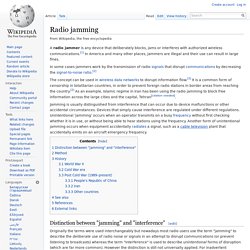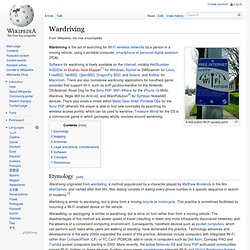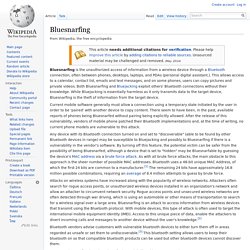

How to Crack a Wpa2-Psk Password with Windows. Cracking_wpa. Version: 1.20 March 07, 2010 By: darkAudax Introduction This tutorial walks you through cracking WPA/WPA2 networks which use pre-shared keys.

I recommend you do some background reading to better understand what WPA/WPA2 is. The Wiki links page has a WPA/WPA2 section. The best document describing WPA is Wi-Fi Security - WEP, WPA and WPA2. How to Crack a Wi-Fi Network's WPA Password with Reaver. How to Crack a Wpa2-Psk Password with Windows. Wi-Fi Tip - Disable SSID Broadcast.
Wi-Fi Alliance. There are three primary approaches to network setup within Wi-Fi Protected Setup: push-button, PIN entry, and Near Field Communication (NFC).

PIN entry is mandatory in all Wi-Fi Protected Setup devices, while push-button and NFC are optional and may also be found in some devices. Push-button configuration (PBC): in some Wi-Fi Protected Setup networks, the user may connect multiple devices to the network and enable data encryption by pushing a button. The access point/wireless router will have a physical button, and other devices may have a physical or software-based button. Users should be aware that during the two-minute setup period which follows the push of the button, unintended devices could join the network if they are in range. Packet analyzer. Packet capture is the process of intercepting and logging traffic.

Capabilities[edit] On wireless LANs, one can capture traffic on a particular channel, or on several channels when using multiple adapters. The captured information is decoded from raw digital form into a human-readable format that permits users of the protocol analyzer to easily review the exchanged information. Protocol analyzers vary in their abilities to display data in multiple views, automatically detect errors, determine the root causes of errors, generate timing diagrams, reconstruct TCP and UDP data streams, etc. [citation needed] Some protocol analyzers can also generate traffic and thus act as the reference device; these can act as protocol testers. Security At the Edge: Locking Down the Network Perimeter. Rogue access point. A rogue access point is a wireless access point that has either been installed on a secure company network without explicit authorization from a local network administrator,[1] or has been created to allow a hacker to conduct a man-in-the-middle attack.

Rogue access points of the first kind can pose a security threat to large organizations with many employees, because anyone with access to the premises can install (maliciously or non-maliciously) an inexpensive wireless router that can potentially allow access to a secure network to unauthorized parties. Rogue access points of the second kind target networks that do not employ mutual authentication (client-server server-client) and may be used in conjunction with a rogue RADIUS server, depending on security configuration of the target network. To prevent the installation of rogue access points, organizations can install wireless intrusion prevention systems to monitor the radio spectrum for unauthorized access points. See also[edit] Evil twin (wireless networks) Evil twin is a term for a rogue Wi-Fi access point that appears to be a legitimate one offered on the premises, but actually has been set up to eavesdrop on wireless communications.[1] This type of evil twin attack may be used to steal the passwords of unsuspecting users by either snooping the communication link or by phishing, which involves setting up a fraudulent web site and luring people there.[2] The attacker uses a bogus wireless access point, purporting to provide wireless Internet services, but snooping on the traffic.

When the users log into unprotected (non-HTTPS) bank or e-mail accounts, the attacker has access to the entire transaction, since it is sent through their equipment. Users think they have logged on to a wireless hotspot connection when in fact they have been tricked into connecting to its evil twin by it sending a stronger signal within proximity to the wireless client. Most existing evil twin detection solutions can be classified into two categories.
What Is a Packet Sniffer? (with pictures) A packet sniffer is a device or program that allows the user to eavesdrop on traffic traveling between networked computers.

The program will capture data that is addressed to other machines, saving it for later analysis. All information that travels across a network is sent in "packets. " For example, when an email is sent from one computer to another, it is first broken up into smaller segments. Each segment has the destination address attached, the source address, and other information such as the number of packets and reassembly order. Secon11.pdf. Radio jamming. A radio jammer is any device that deliberately blocks, jams or interferes with authorized wireless communications.[1] In America and many other places, jammers are illegal and their use can result in large fines.

The concept can be used in wireless data networks to disrupt information flow.[3] It is a common form of censorship in totalitarian countries, in order to prevent foreign radio stations in border areas from reaching the country.[2] As an example, Islamic regime in Iran has been using the radio jamming to block free information across the large cities and the capital, Tehran[citation needed]. Jamming is usually distinguished from interference that can occur due to device malfunctions or other accidental circumstances. Devices that simply cause interference are regulated under different regulations. Unintentional 'jamming' occurs when an operator transmits on a busy frequency without first checking whether it is in use, or without being able to hear stations using the frequency. Wardriving. A free public Wi-Fi access point Wardriving is the act of searching for Wi-Fi wireless networks by a person in a moving vehicle, using a portable computer, smartphone or personal digital assistant (PDA).

Etymology[edit] Wardriving originated from wardialing, a method popularized by a character played by Matthew Broderick in the film WarGames, and named after that film. War dialing consists of dialing every phone number in a specific sequence in search of modems.[3] Wall Of Sheep Hacker Group Exposes NFC's Risks At Def Con 2013. Bluejacking. This Siemens M75 is Bluejacking the Sony Ericsson K600i pictured below This Sony Ericsson K600i is getting Bluejacked by the Siemens M75 pictured above.

The text at the bottom of the screen reads "Add to contacts? " in Norwegian. Bluejacking is the sending of unsolicited messages over Bluetooth to Bluetooth-enabled devices such as mobile phones, PDAs or laptop computers, sending a vCard which typically contains a message in the name field (i.e., for bluedating or bluechat) to another Bluetooth-enabled device via the OBEX protocol.
Bluetooth has a very limited range, usually around 10 metres (32.8 ft) on mobile phones, but laptops can reach up to 100 metres (328 ft) with powerful (Class 1) transmitters. Bluesnarfing. Bluesnarfing is the unauthorized access of information from a wireless device through a Bluetooth connection, often between phones, desktops, laptops, and PDAs (personal digital assistant.).

This allows access to a calendar, contact list, emails and text messages, and on some phones, users can copy pictures and private videos. Both Bluesnarfing and Bluejacking exploit others' Bluetooth connections without their knowledge. While Bluejacking is essentially harmless as it only transmits data to the target device, Bluesnarfing is the theft of information from the target device. Current mobile software generally must allow a connection using a temporary state initiated by the user in order to be 'paired' with another device to copy content. There seem to have been, in the past, available reports of phones being Bluesnarfed without pairing being explicitly allowed. Attacks on wireless systems have increased along with the popularity of wireless networks. See also[edit] How secure is NFC tech? - HowStuffWorks. In the near future, your technological world might be overtaken by near field. No, not the corn field that's across the road.
We're talking about near-field communication (NFC), which gadget manufacturers, retailers and many other organizations hope will bring powerful new features to smartphones and much more.